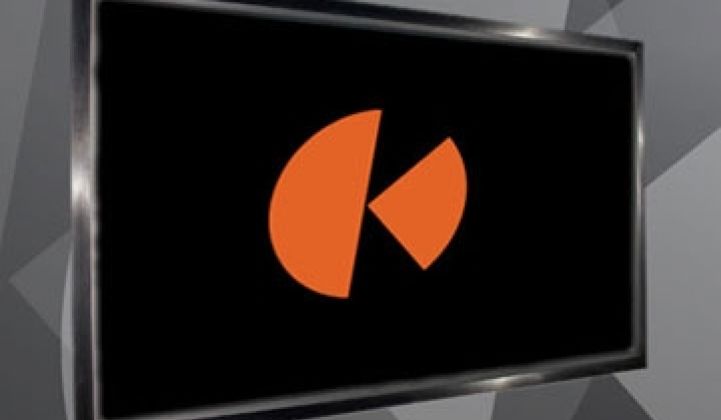Liquid to solid to gas and back to solid.
If startup Kateeva is correct, a more elaborate version of that recipe might transform organic light emitting diodes (OLEDs) from a niche market into a mainstream technology for TVs, computer screens and lights.
The company has devised a method for depositing the light-emitting organic materials with inkjet printers and a micro-dryer called a T Jet (for thermal jet) along with proprietary inks that effectively will let manufacturers employ generation 8.5 substrates – which measure more than 6 feet a side – to produce OLEDs.
OLEDs are currently made on Gen 3.5 substrates, which measure 61 centimeters by 72 centimeters, hardly big enough for that 50-inch screen.
In four years or more, OLED TVs made on Kateeva's formulas could cost about 70 percent of what it would cost to build a standard LCD TV and even less than an LCD-LED TV, asserted Conor Madigan, a co-founder and the CEO. Such TVs would use a fraction of the power and contain half of the components.
"By 2013, OLEDs will really be established at a volume manufacturing level. They [TV manufacturers] see a market where small margins rule and higher costs lose," he said. "The technology scales gracefully."
Like algae biodiesel, carbon nanotubes and electric cars, OLEDs are miracle items that more people read about than actually own. OLEDs are thin, flexible sheets of materials that emit their own light. Researchers at USC and Princeton have published reports stating that OLEDs can conceivably convert nearly 100 percent of the power injected into them into light.
In the end, that could mean TVs or lights a few millimeters thick that weigh a fraction of their contemporaries, cost less and don't sport bulbs that generate heat and break. OLED TVs and lights could even be transparent, so homeowners could replace windows with them.
Nokia, Dell, General Electric, Sylvania and others have all pledge to adopt them. Proponents say it could be a $100 billion market in a few years with $4.5 billion coming from lighting alone.
But, oops, reality. Producing OLEDs remains expensive and problematic. Sony released the first OLED TV, the XEL-1, in 2007. It measured 11-inches in diameter and sold for $2,500. Two years later, the XEL-1 still measures 11-inches across and sells for $2,500. Panasonic, Sharp, Hitachi and others have said they want to produce OLED TVs, but in the hazy future when manufacturing issues can be resolved. LG will release an OLED TV soon, but it measures only 15 inches.
"It will be a while. All of the same issues that have existed for the last couple of years-stability of manufacturing, scaling to large size-still exist," said David Steel, senior vice president of marketing at Samsung Electronics.
Sylvania sells an OLED lamp, for $10,000. The only mass market for OLEDs right now is for screens for high-end phones.
The dilemma arises largely from how OLEDs are manufactured. A substrate inside of a vacuum deposition chamber is covered with an intricately patterned mask. Chemical gases injected into the chamber coat the exposed portions of the substrate and, when they solidify, become circuits. After several mask layers, the light emitting pixels come into being.
Unfortunately, the mask can only get so big. The further away a mask feature is from the source of the gas, the odds increase that the pixel will contain defects. The z dimension, or thickness, of the mask can also distort.
To this end, some companies have tried lasers and inkjet printing. While inkjets allow the source of materials to be placed in close proximity to mask features, inkjets can be inaccurate for electronics printing and one layer can bleed into the next.
"Each layer has to be insoluble to the next," Madigan said.
Kateeva gets around this problem with the T Jet, which sits between the inkjet nozzles and the substrate. The material is first heated to 100 Celsius to evaporate the carrier liquids. The remaining solids then get heated to 300 Celsius, turned into a gas, and deposited onto the substrate, where it solidifies.
In a sense, it's similar to conventional OLED manufacturing, but the material is deposited in closer proximity. Larger substrates mean cheaper (and larger) TVs and other products because more displays essentially get manufactured at the same time.
Although the company will sell equipment, approximately 70 percent of its revenue could come from the inks, according to Sass Somekh, a former chip equipment exec turned VC at Musea Ventures. (Somekh co-founded Kateeva and invested in it along with Sigma Partners and Varian.) Each customer will likely demand its own nuanced tweak on the materials, but that's how the TV industry works today: Most manufacturers buy their liquid crystal from Merck. Some of the company's employees hail from Applied Materials and other equipment vendors.
The first big test will come in the second quarter when Kateeva ships prototype systems for processing Gen 3.5 substrates. Bigger ones will follow.
Learn how to differentiate your company through greener product lines at Greening the Supply Chain on September 17 in Boston.




